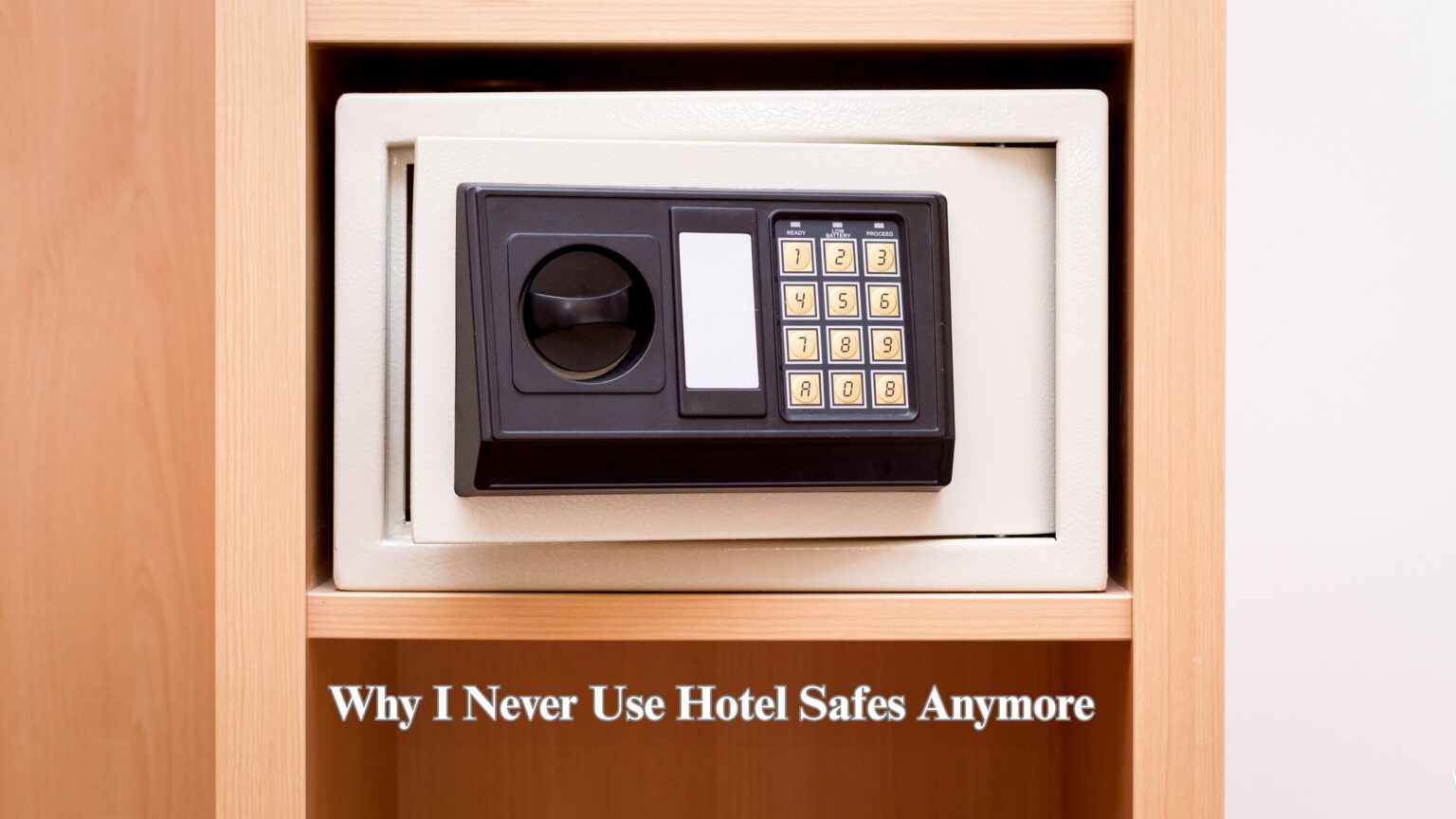As a frequent traveler who’s stayed in hundreds of hotels across six continents, I used to religiously lock my valuables in hotel room safes. It seemed like the obvious choice – after all, hotels provide these security boxes specifically to protect guests’ belongings, right? However, after several eye-opening experiences and countless conversations with security experts and hotel staff, I’ve completely changed my approach to protecting valuables while traveling.
The Hotel Safe Myth: Why They’re Not as Secure as You Think
The Master Code Problem
The most significant issue with hotel safes is something most guests never consider: master codes. Every hotel safe has a master code that allows hotel staff to access it regardless of what personal code you’ve set. While this serves legitimate purposes like assisting guests who forget their codes or accessing safes after checkout, it also creates a significant security vulnerability.
During my stay at a luxury resort in Southeast Asia, I witnessed housekeeping staff casually opening safes in multiple rooms during their cleaning rounds. When I inquired, they explained they were checking for forgotten items – a common practice that highlighted just how easily these “secure” containers can be accessed.
Staff Access and Insider Threats
Hotel employees, from housekeeping to maintenance staff, often have access to master codes or override devices. While most hotel workers are honest and professional, the reality is that you’re trusting multiple strangers with access to your most valuable possessions. According to hospitality industry reports, a significant percentage of hotel theft incidents involve current or former employees.
Outdated Technology and Poor Maintenance
Many hotel safes use outdated technology that security experts can easily bypass. I’ve encountered safes with worn keypads where you could see which numbers were most frequently pressed based on wear patterns. Others had loose hinges, faulty locking mechanisms, or batteries so low that any code would work.
In a boutique hotel in Eastern Europe, my safe wouldn’t lock properly, and when maintenance arrived, they demonstrated how a simple paperclip could override the electronic mechanism. This experience was both alarming and enlightening.
The False Sense of Security
Perhaps the most dangerous aspect of hotel safes is the false sense of security they provide. Many travelers become complacent, storing not just jewelry and cash, but also backup credit cards, spare phones, and important documents all in one easily accessible location. This puts all your eggs in one basket that’s potentially easier to crack than you might think.
READ ALSO: Why I Always Pack These 5 Items to Avoid Getting Sick on Vacation
What I Do Instead: My Current Security Strategy
1. Distributed Storage Approach
Instead of centralizing all valuables in one location, I distribute them across multiple hiding spots and carry methods. This ensures that even if one cache is discovered or compromised, I don’t lose everything at once.
Primary valuables like my main wallet and phone stay with me at all times. Secondary items like backup cards and emergency cash get distributed between my luggage, different pockets, and creative hiding spots throughout the room.
2. Body-Worn Security Solutions
I’ve invested in several discreet, body-worn security options that have proven far more reliable than any hotel safe:
Money belts and hidden pockets: Modern versions are much more comfortable and less obvious than older designs. I use a slim money belt for backup cards and emergency cash that sits comfortably under clothing.
Bra stashes and leg holsters: For female travelers, specialized bra pockets and thigh holsters provide excellent security for small valuable items. These are virtually undetectable and stay with you always.
Shoe compartments: Specially designed insoles with hidden compartments work well for backup cash and are extremely difficult to detect.
3. Strategic Room Hiding Spots
When I need to leave items in my room, I use creative but logical hiding spots that thieves typically don’t check:
Inside dirty laundry: Criminals rarely want to rifle through used clothing. I wrap valuable items in plastic bags and place them inside worn clothes in my laundry bag.
Toiletry containers: Empty, clean containers from toiletries can hold small valuables. I’ve used everything from empty shampoo bottles to contact lens cases for this purpose.
Book safes: If I’m traveling with reading material, a hollowed-out book provides excellent camouflage for important documents or backup cards.
Electronic device cases: Empty camera cases, laptop bags, or even phone charger organizers make excellent decoy storage for non-electronic valuables.
4. Digital Security Measures
Modern travel security isn’t just about physical items. I’ve implemented several digital strategies that reduce my reliance on carrying physical valuables:
Digital copies of documents: I store encrypted copies of passports, IDs, and important documents in secure cloud storage. This eliminates the need to carry physical backups in most situations.
Mobile payment systems: By setting up Apple Pay, Google Pay, and other mobile payment options, I can minimize the amount of cash and cards I need to carry.
Travel-specific credit cards: I use cards specifically designated for travel that can be quickly frozen and replaced if stolen, rather than risking my primary banking relationships.
5. Psychological Deterrents
Part of my strategy involves making my room and belongings less appealing targets:
Organized appearance: I keep my room tidy and organized, giving the impression that I’m meticulous and would quickly notice if something were missing.
Fake valuables: I sometimes leave inexpensive but realistic-looking jewelry or electronics in obvious places, while hiding real valuables elsewhere.
Local currency only: I avoid displaying foreign currency or expensive items that immediately mark me as a wealthy tourist.
Advanced Security Techniques for High-Value Items
For Expensive Jewelry and Watches
When traveling with high-value jewelry, I employ several specialized techniques:
Decoy pieces: I carry some attractive but inexpensive jewelry that I wear openly, while keeping valuable pieces hidden.
Component separation: For expensive watches, I remove the band and store it separately from the face, making the item less recognizable and functional if stolen.
Insurance documentation: I photograph valuable items and maintain detailed records, including serial numbers, stored separately from the items themselves.
For Important Documents
Document security requires a multi-layered approach:
Primary documents like passports stay in a slim travel wallet that I carry at all times when outside the hotel.
Backup documents get distributed between multiple locations, with some hidden in the room and others carried separately.
Emergency contacts and account numbers are memorized and stored digitally in encrypted form, never written down in plain text.
For Electronics and Devices
Modern travelers often carry multiple expensive devices. My approach includes:
Primary device security: My main phone and laptop stay with me or get locked in hard-sided luggage with TSA locks (more as deterrents than actual security).
Backup devices: Secondary phones or tablets get hidden using the same techniques as other valuables.
Data security: All devices have remote wipe capabilities enabled, and sensitive data is encrypted and backed up securely.
Hotel Types and Risk Assessment
Luxury Hotels vs. Budget Accommodations
Interestingly, I’ve found that hotel price point doesn’t necessarily correlate with safe security. Some luxury hotels have older, less secure safes, while some budget accommodations have invested in newer technology. The key is personal assessment rather than assumptions based on hotel category.
International Considerations
Different regions present varying security challenges. In some countries, I’m more concerned about official corruption and may avoid safes entirely to prevent complications during potential room inspections. In others, the primary concern is opportunistic theft by outsiders.
Short-term vs. Extended Stays
For stays longer than a few days, I gradually increase my security measures, establishing better hiding spots and assessing staff patterns. Short stays require more portable solutions since I haven’t had time to evaluate the specific security environment.
READ ALSO: I Got Food Poisoning Abroad 3 Times—Here’s How I Finally Learned to Eat Safely While Traveling
Common Mistakes to Avoid
The “Out of Sight, Out of Mind” Trap
Just because something is hidden doesn’t mean it’s secure. Many travelers hide valuables in obvious places like suitcase pockets or toiletry bags – the first places thieves check.
Over-Reliance on Technology
While digital solutions are helpful, they shouldn’t be your only backup. I always maintain some physical backup options in case of device failure or network issues.
Ignoring Local Crime Patterns
Each destination has specific security concerns. I research common crime types and theft methods for each location I visit, adjusting my security strategy accordingly.
Inadequate Insurance Coverage
No security method is 100% effective. I maintain comprehensive travel insurance that covers theft of personal items, ensuring financial protection even if security measures fail.
Emergency Protocols: When Things Go Wrong
Despite the best security measures, theft can still occur. I maintain detailed emergency protocols:
Immediate response procedures include contacting local authorities, notifying the hotel management, and beginning the insurance claim process.
Financial security measures involve immediately contacting banks and credit card companies to freeze accounts and request emergency replacements.
Communication plans ensure I can contact family and continue my travels even if primary communication devices are stolen.
The Cost-Benefit Analysis
Implementing these security measures requires some investment in specialized gear and increased vigilance, but the costs are minimal compared to potential losses. A good money belt costs less than $30, while losing a passport abroad can cost hundreds in replacement fees and travel delays.
More importantly, the peace of mind from knowing my security doesn’t depend on trusting strangers with master codes is invaluable. I sleep better knowing my valuables are truly secure using methods I control completely.
Conclusion: Taking Control of Your Travel Security
Hotel safes represent a fundamental security flaw: they require you to trust strangers with access to your most valuable possessions. By developing a personal security strategy based on distributed storage, body-worn solutions, and creative hiding techniques, you maintain complete control over your valuables’ security.
The key is developing a systematic approach that becomes second nature. After implementing these methods for several years, they require minimal additional effort while providing significantly better security than any hotel safe could offer.
Remember, the best security system is one that doesn’t advertise its existence. By avoiding obvious targets like hotel safes and implementing discrete, personal security measures, you not only protect your valuables better but also reduce your profile as a potential victim.
Travel should be about exploring new places and creating memories, not worrying about your possessions. By taking control of your security strategy, you can focus on what really matters while knowing your valuables are truly safe.
In another related, When Apps Fail and WiFi Dies: How Digital Dependence Nearly Ruined My Travels







